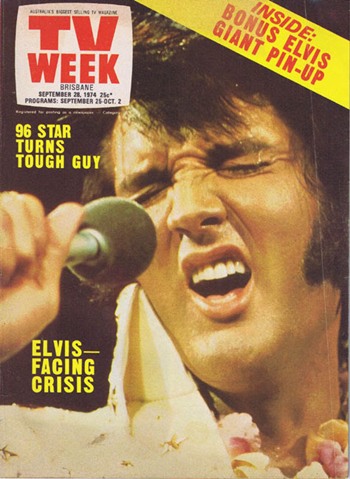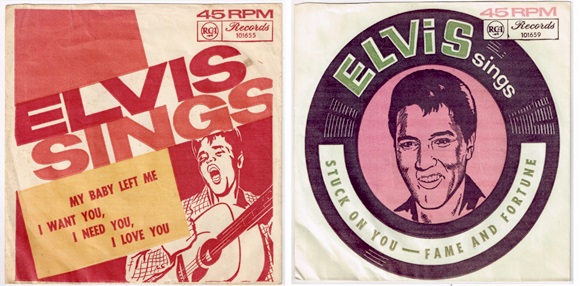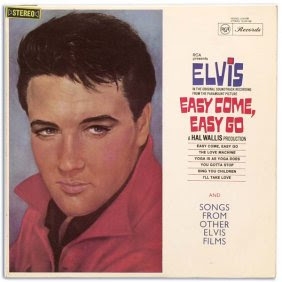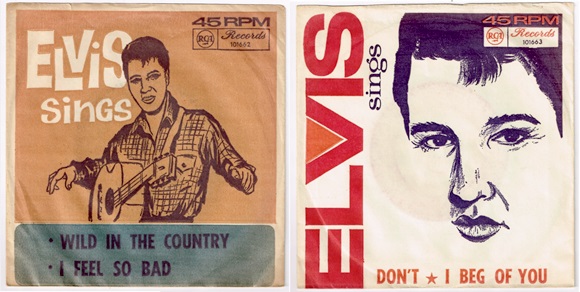Copyright the Elvis Information Network.
Elvis Presley, Elvis and Graceland are trademarks of Elvis Presley Enterprises.
The Elvis Information Network has been running since 1986 and is an EPE officially recognised Elvis fan club.
 |
 |

Interview conducted by Nigel Patterson, January 2016 --------------------------------------
.......The Interview.......EIN: Who is Glenn Reimer? GR: I am married father with three grown up children and I recently became a grandfather for the first time. My son Aaron (no explanation is needed there!) recently graduated with a masters degree in architecture, my eldest daughter is a teacher and my youngest daughter works for the government. But me? I am just an ordinary person who likes listening to music. I am a fan of AC/DC, ABBA, BEE GEES, Creedence Clearwater Revival, Fleetwood Mac, Neil Diamond, Neil Young, Glen Campbell and just about anything with the Motown Sound. So as you can see I like music from the late 1960s and 1970s the most. I go to concerts when I can with the last ones being Bobby Rydell, AC/DC and Fleetwood Mac. I also have an interest in military history, biographies and many sports like motor racing, cricket etc. EIN: How and when did you become interested in Elvis? GR: My first memory of Elvis is from the early 1970s. We had a lady who lived next door who was a big fan and I could always hear Elvis songs being played. I also remember watching the Aloha Special and it was a very hot night and we moved the TV out onto the verandah of our old Queenslander and the lady next door came over and watched it with us and I remember she was disappointed that Elvis didn’t sing Sweet Caroline because Carol was her name. So I would have been eleven years old when I watched that concert. About 12 months later I was selling newspapers near a record store and they had the Rock ’N’ On album on display and they were also playing songs from the album everyday so when I received my pay I ended up buying that record. I never really collected Elvis records as such, I just got albums to listen to which ended up being on both vinyl and cassette and then compact disc. I just didn’t buy anything and everything that came out. I didn’t even go to record fairs. It wasn’t until the mid 1990s that I ended up being what I would call a “collector.” Before that I was just simply a fan who had a few albums to listen to and I would watch his movies when they came on TV. In 1989 I was fortunate enough to see Graceland. GR: I purchased the Australian radio spot record for G.I. Blues about 15 years ago and I contacted EIN to see if they knew anyone that could tell me more about it. Pretty quickly I received an email from Peter “Bob” Hayden and since then we have been discussing everything Elvis by email or telephone. It has been a great partnership and we are always helping each other. For example I helped Bob with his Elvis’ 1968 Cadillac Tour of Australia and Bobby Rydell books and he has been in invaluable source when it comes to contacts in the collectors world and the early history of rock’n’roll in Australia. Without Bob’s help my Australian guide couldn’t have been done.
GR: I suppose the groundwork started over six years ago and the first draft was done about three years ago but due to my eldest daughter becoming ill the book was sort of put on hold. One good thing that came out of a bad situation is that more information was collected during that extended time. GR: I don’t really know. I have pictures of all the original single, EP and albums covers plus some reissues plus images of all the sheet music, magazine covers, movie posters, catalogues etc. It just goes on. EIN Note: Subsequent to our interview, Glenn and Bob advised there are around a staggering, but not surprising, 1,600 images in the book! GR: I think these records are very interesting because they were supplied to radio stations to promote RCA artists and usually an announcer would introduce each track. The 10inch and 12inch versions usually play for 15 minutes per side and there could be several artists per side or one artist on each side. The first one, SP-1 was released in 1958 however the earliest known SP record with an Elvis track is SP-19 which was issued for radio play in August 1962. I don’t know if every release from SP-1 has been checked because these records are hard to find and I don’t know anyone that has the complete series but it seems amazing that it wasn’t until 1962 before an Elvis track was promoted in this way. My guide lists the six SP records that are known to exist but people who have been around a lot longer than I have have assured me that is all there is. The most collectable are SP-19 and SP-55 because all of one side on these two records contains all Elvis tracks. SP-55, which was issued for radio play in May 1966 is the most sought after because it promotes the Australian only cartoon portrait series single releases that were issued in 1965 and 1966 (see examples below). The RCA jackets and introductory letter that came with these records are extremely rare because I assume the radio stations would have discarded them.
EIN: Glenn, you include information on various ‘imported’ RCA records that could be found in Australian record stores. Please tell us about these and how you tracked down information on them.
EIN: The world of Elvis collecting (and selling) is a particularly volatile one where values on auction sites, such as ebay, fluctuate widely. How did you determine the values for each listing? GR: Listing all the variations was the most time consuming part of the book and pricing them was a nightmare. I knew that not everyone would agree with my views but remember it is a GUIDE and should be used as such. I know people will always have disagreements about prices because everyone collects or has an interest in different things. Some collectors will pay good money for some of the orange label single reissues whilst others don’t have the same interest in them. But when it came down to setting prices the figures I used were based on my own experiences of going to record fairs, record stores and watching internet auctions sites for twenty years. Of course prices will go up and down. Using everyone's favourite the Easy Come, Easy Go album as an example there was a time when copies would rarely appear on auction sites and when one did it went for a good price but recently there have been several copies available so prices have dropped.
GR: Go Set only lasted a very short period. Chart research like sales research is very limited because it just wasn’t documented properly at the time or not at all. GR: Not much unfortunately. I only found snippets here and there so if anyone has any information I would be more than happy to receive it but I have been informed that hardly anything exists from the 1950s and 1960s. Like most businesses RCA relocated offices, restructured and at one time in the 1950s there was a fire in the building they were occupying so who knows what got destroyed then. EIN: Your research uncovered many rare and obscure archival materials relating to Elvis’ vinyl and film releases in Australia. What were some of your favourite discoveries? GR: I really liked finding those old newspaper reviews (good or bad) and advertisements by RCA and record stores but it could be something simple like that little black band across the spine of RCA albums. One day I found an RCA catalogue that was given to record stores and it explained that that little band was a price guide band. When I was trying to find out the release dates for Elvis’ films around Australia I was amazed how there would always be something happening like competitions and dances when an Elvis film was showing. Some of these prizes would include holidays and there was even a fashion parade in Brisbane with ‘Tickle Me Pink’ as the new colour sensation when Tickle Me had an amazing seven week run here. This is at time when Beatlemania was very strong yet Elvis was still extremely popular which was very pleasing to know. I would also have to include the July 1956 Record Guide magazine with Elvis on the cover which probably is the first time an Australian publication had a picture of Elvis on the front cover. I first came across that in 2009 and I only know one person who has a copy of it. On the downside I was disappointed to find that when I watched the Aloha Special on that hot summer night in 1973 that it wasn’t broadcast live into Brisbane but only Sydney and Melbourne. So for nearly 40 years I always believed I watched it live when in fact I watched the concert nearly a month after the live broadcast!. EIN: What were the hardest things to find and/or substantiate? GR: Just about everything!. Early RCA documents as I mentioned earlier from what I have been told from reliable sources don’t exist anymore and the very few that I have found came from other collectors. Chart information and record catalogues are others things. When I put my book together it was never my intention to go into any great detail about any particular subject because of the limited information that was available. I just wanted to create a reference guide for a collector who simply wants to know what Elvis material from Australia is out there to collect (and how to identify it). A lot of information such as recording session information, photographs and stories about Elvis are available on the internet and in other books so this book is about the product rather than the person. I wanted to publish a book that a collector like myself would continually use. For example when I check internet auction sites or when I go to record fairs I would go to the record and sleeve issue and variations page in the back of my book and refer to it to see if I have that record listed or in my collection. I do the same with sheet music and movie posters even though I don’t collect them myself because I want to make sure that I haven’t missed anything. I certainly don’t see it as book that you would read once and leave on the shelf – unless you are not a record collector and you just want the book for your Elvis book collection, which isn’t a bad thing either!.
GR: Like anything to do with collecting - research and research again and get advice and know who to trust. Know what you want and be patient because something will always turn up but most importantly just enjoy it. EIN: How big is the Elvis collector network in Australia and how can new collectors become connected with it? GR: To be honest I don’t really know about how big the collector network is but speaking with other collectors from around Australia, Brisbane doesn’t seem to be anywhere near as a good as Sydney, Melbourne or even Adelaide. I have only met a couple of Elvis collectors at record fairs here in Brisbane but one of those who I considered to be the biggest here is unfortunately no longer with us. I often speak with non-Elvis record collectors as they can always help out and are good to talk to. One collector who I often to talk to at records fairs doesn’t collect Elvis at all but he has some very interesting stuff like catalogues and magazines from the 1950s and 1960s which was a big help. Also if you go to record fairs and stores often you will become a familiar face so people will get to know you eventually. EIN: Please tell us about the feedback you have received since the book was published? GR: It has been positive which is good and encouraging. When I receive an email I would send some scans of pages from the book and explain what the book is about because I wanted to make sure that people knew exactly what they were buying. EIN: The first printing of the book has been a limited edition of 100 copies and is “sold out”. Have you made a decision on printing more copies? GR: I’m not sure where the ‘Limited Edition’ part came from but the book is self-published and is a hobby so I just wanted to keep everything simple and manageable so I found a local printer with who I could deal with in person. This enabled me to do everything without having to rely on others. To do this I had to keep the print run low but high enough to keep print costs down and this is why I haven’t advertised the book anywhere, I only notified EIN and one other website when the book was available and just let it go from there. In fact they were nearly all gone within ten days of the book being mentioned on EIN. But as a collector myself I wanted the book to become a collectable item so to do this I want to keep the numbers printed low but at the same time I also wanted to ensure that other collectors like myself who wanted a copy could get one so it became a bit of a balancing act. So yes only 100 copies were printed originally but I ended up receiving more requests than I had books and when I received a large overseas order I realised I needed to print more books but not nearly as many as the first order of 100 books. I only have a few left from the second print run so when they are gone I think that will be it because doing print runs of 10, 20 copies at a time is very expensive. GR: I will only release a revised or second edition if enough new material is forwarded to me to make it worthwhile to do so and the demand is there for it but in saying that any such book would be at least 12 months away because I want to give as much time as possible for people to come forward plus to follow up and any new leads. I really do hope I am contacted because we are all getting older and as time goes by chances are that more material will be lost forever. The other thing is that not every library or collector that I know has everything so I am sure there is much more stuff out there that is yet to be found or shared. I keep hearing stories about who has what but it seems some people just aren’t interested anymore or would prefer to keep things to themselves. That’s their right I suppose but it’s really unfortunate that some Elvis treasures are being kept hidden away and may never been seen again.
Australian only "Portrait" series - two of the rare 45rpm sleeves
GR: I don’t want people to assume that something that they have is something that I have probably seen. That would be a mistake. It doesn’t take much to send an email with a scan attached so if you have anything that is not in the book don’t hesitate to send it to me. I set up the lonelymanpublications@gmail.com email account specifically for my book so anyone with any information or who wants a copy of the book can contact me by using that email address. EIN: Glenn, is there anything else you would like to say to EIN readers? GR: Just to say a big thank you to everyone who helped with my book and also to those who have purchased a copy. If anyone has any questions or they need help with anything about Australian Elvis related material or advice on where or how I found some of the material used in my book just contact me. I am always happy to help other Elvis fans. EIN: Glenn, thank you very much for taking the time to talk with us. We know many Elvis collectors and general fans will welcome your insight to the history of Elvis in Australia and enjoy your thoroughly researched and interesting book. Be quick to secure one of the few copies of the book left:......contact Glenn Reimer Read EIN's review of Glenn's book .
. |
|







